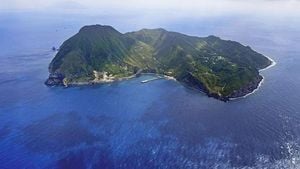Japan is currently grappling with a wave of anxiety stirred by an unusual mix of real seismic activity and a decades-old manga prediction that has captured public imagination and shaken travel plans across Asia.
The tension centers around the Tokara Islands, a cluster of small islands southwest of Kagoshima Prefecture in southern Japan. Since late June 2025, the region has experienced an unprecedented swarm of nearly 1,000 earthquakes measuring magnitude 1 or higher, with several notable quakes reaching magnitudes above 5.0. On July 3 alone, the Japan Meteorological Agency (JMA) recorded a magnitude 5.0 quake at 12:49 a.m. approximately 291 kilometers southwest of Kagoshima, followed by a magnitude 5.5 tremor at 4:13 p.m. near Toshima Village. That afternoon, over 20 smaller quakes rattled the area within just two hours.
The previous day, a magnitude 5.6 earthquake struck near the Tokara Islands, registering a seismic intensity of 5-weak on the JMA scale, enough to cause dishes and books to tumble from shelves and to instill fear across the local population. This level of seismic activity is exceptional for the area, far surpassing previous swarm records such as the 673 quakes observed during earlier episodes in December 2021 and September 2023.
Experts, including Professor Hisayoshi Yokose of Kumamoto University, suggest that the heightened seismicity could be linked to the interaction of three active fault lines in the area, an increase from the two faults believed responsible for earlier swarms. The Japan Meteorological Agency has cautioned that the end of this seismic swarm is uncertain and urged vigilance against potential stronger tremors in the near term.
Adding to the public unease is a long-standing rumor rooted in the 1999 manga My Future I Saw by Japanese artist Tatsuya Ryoga. The manga, which has gained renewed attention, allegedly predicted a catastrophic earthquake in July 2025 near the Nankai Trough, a submarine trench off Japan's southern coast. The Nankai Trough is historically known for generating mega-earthquakes of magnitude 8 to 9 roughly every 100 to 150 years, with the last major event occurring in the 1940s.
Tatsuya is notable for having garnered attention for purportedly predicting the 2011 Great East Japan Earthquake and the COVID-19 pandemic in his earlier works. His 1999 manga describes a dream of a massive earthquake striking near the Nankai Trough in July 2025, triggering tsunamis that impact Pacific Rim countries. While the author himself has clarified that the dates in the manga are fictional, and the JMA has labeled such predictions as baseless rumors, the fear has nonetheless taken hold, especially on social media platforms.
This fear has tangible consequences beyond just public sentiment. The tourism industry has felt the impact acutely. Hong Kong's Greater Bay Airlines announced the suspension of regular flights between Hong Kong and two smaller Japanese cities—Yonago in Tottori Prefecture and Tokushima in Tokushima Prefecture—starting September 1, 2025, citing decreased demand linked to the earthquake rumors. This move follows earlier reductions in flights to Tokushima and Sendai.
Nomura Securities released a sobering report estimating that Japan's tourism sector could suffer losses up to 56 billion yen (approximately 529.55 billion South Korean won) in July 2025 alone due to these unfounded earthquake predictions. The report forecasts a reduction of about 2.4 million Japanese tourists traveling within Asia between May and October 2025, a significant blow to the sector.
Indeed, data from May 2025 show that visitor numbers from Hong Kong to Japan dropped by 11.2% compared to the previous year, the only major region to exhibit such a decline. This trend reflects the broader anxiety spreading through East Asia, fueled by the manga's eerie timing and the real seismic unrest around the Tokara Islands.
Despite these concerns, experts emphasize that predicting the exact timing and location of earthquakes remains beyond current scientific capabilities. Professor Kim Young-seok of Pukyong National University in South Korea stressed, "Modern science cannot pinpoint the exact timing of an earthquake, and the manga's prediction falls into the realm of supernatural imagination." Similarly, Professor Oh Chang-hwan from Chonbuk National University pointed out that while volcanic eruptions can sometimes be forecasted, earthquakes cannot be predicted with such precision. "We can warn about high-risk zones, but not specific dates or locations," he said.
Professor Junichi Nakajima of the Tokyo Institute of Technology also debunked the so-called "Tokara Rule," a popular social media theory claiming that a swarm of earthquakes near the Tokara Islands signals an impending large quake elsewhere in Japan. He explained that the recent seismic activity and the Nankai Trough mega-earthquake are geographically distinct phenomena, making direct connections unlikely.
Nonetheless, experts concur that the Nankai Trough remains a significant seismic hazard. The Japanese government’s disaster scenario report from March 2025 warns of an 80% probability that a magnitude 8 to 9 earthquake will strike the Nankai Trough within the next 30 years. The projected consequences are staggering: up to 298,000 fatalities, 12.3 million displaced people, 2.35 million buildings destroyed, 900,000 injuries, and economic damages estimated at 292 trillion yen (approximately 2,744 trillion South Korean won).
Given these risks, specialists like Professor Oh emphasize the importance of robust disaster preparedness, including earthquake-resistant construction, fire prevention, and epidemic control to mitigate secondary damages. Professor Kim advises travelers planning to visit Japan to consider safer destinations, suggesting, "If possible, choose relatively safer western regions rather than high-risk areas like Kyushu." This practical guidance aims to balance caution without succumbing to unfounded fears.
In the face of swirling rumors and real seismic unrest, the Japan Meteorological Agency held an urgent press conference on July 3, 2025, to address public concerns. They firmly stated there is "probably no connection" between the ongoing Tokara Islands earthquakes and the anticipated Nankai Trough mega-earthquake. Moreover, they reiterated that any earthquake predictions specifying exact dates are unfounded rumors.
As Japan navigates this tense moment, the blend of science, folklore, and public anxiety underscores the challenges of communicating risk in a seismically active nation. While the manga's prophecy remains a work of fiction, the real threat of a major earthquake persists, reminding all of the need for vigilance and preparedness.




